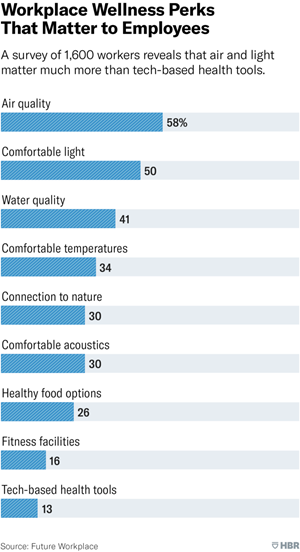
What Employees Want in a Workspace is Not What You Might Expect
A recent Harvard study collected data on what employees say they want from their workspaces and what employers are actually investing in. Worker preferences are often going unnoticed.
In the coming year, employers are expected to spend an average of $3.6 million on wellness programs for their employees. The results of a recent Harvard study suggest that these wellness programs might not be yielding the intended results for worker health and happiness.
Future Workplace and View surveyed 1,601 workers across North America to determine which wellness perks employees wanted, how these impacted productivity, and how companies were investing or not investing in these preferences.
Employees surprisingly want the basics first and foremost: better air quality, access to natural light, and the ability to personalize their workplaces. Poor air quality reportedly affects workers’ ability to concentrate and stay alert, and many workers want the ability to adjust office space components like lighting and temperature. Many also noted that they would also like healthier food options at the office, as healthy food greatly affect physical wellness and productivity as well.
“The number one environmental factor cited in our survey was better air quality. Fifty-eight percent of respondents said that fresh, allergen-free air would improve their wellness. Fifty percent said they would work and feel better with some view of the outdoors, while one third said they would want the ability to adjust the temperature in their workspace. Only one in three survey respondents characterized their office temperature as ideal,” explains the Harvard Business Review article on the survey.
Many companies tend to put resources into wellness programs that employees do not necessarily prioritize for ideal work environments. Aspects like onsite gyms are not as important to employees as other emotional, physical, and environmental factors.
Harvard’s survey, along with others, suggest that prioritizing employee wellness preferences can greatly impact retention and overall satisfaction rates within the company. Another study notes that employees satisfied with their workplaces are “16% more productive, 18% more likely to stay, and 30% more attracted to their company over competitors.” Two-thirds of Harvard’s survey respondents said that a “workplace focused on their health and wellbeing would make them more likely to accept a new job or keep the job they have.”
The Harvard Business Review article on the study gives three steps for employers on how to improve their workplaces for employees:

1. Stop spending money on pointless office perks
The easiest way to avoid using resources where resources are not wanted is by asking employees what they want. Employers can find ways to learn about and survey employees so that office spaces can prioritize employee wellness programs that will truly encourage productivity and health. The Harvard Business Review shares this graphic about preferenced office perks:
2. Personalize when possible
People want to personalize their workspaces the same way they personalize life outside of work: the ability to dim lights, adjust thermostats, alter desk height, and shut out sound distractions. The article goes into detail about how these personalization perks are not reserved for just the higher-up; there are many ways employers can offer these personalization options to everyone in an office.
3. Make workplace wellness holistic
Do not forget that an environment conducive to its employees’ health considers all facts of wellbeing: emotional, physical, and environmental. The solutions to overall company wellness involve collaboration, conversation, and group effort on many levels. No CEO can do it alone.